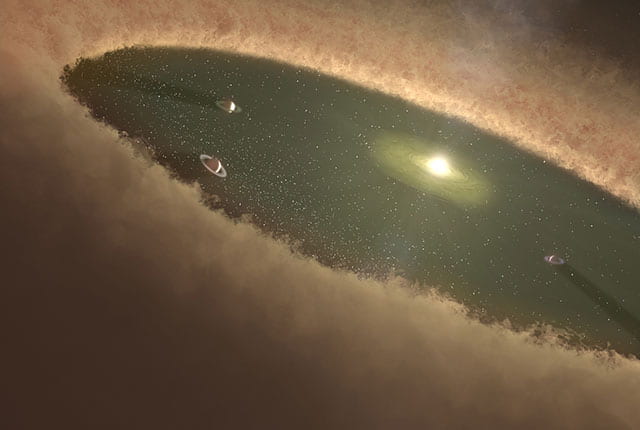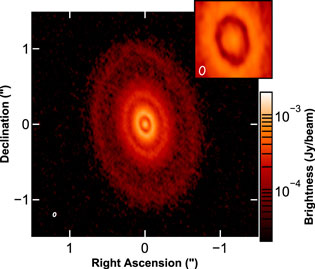Observations of the youngest confirmed exoplanet, CI Tau b, suggest it's still hot from its birth — a point in favor of a quick-start model of formation.

NASA / JPL-Caltech / T. Pyle
How could a hot Jupiter form so close to a star only about 2 million years old? After four years of near-infrared observations, astronomers now have critical insights into the properties and likely origin of CI Tau b, a newborn gas giant in a tight nine-day orbit around its star, 450 light-years away in the constellation Taurus.
Christopher Johns-Krull (Rice University) and Lisa Prato (Lowell Observatory) presented the results of a new study led by Laura Flagg (also at Rice) at the recent American Astronomical Society meeting in St. Louis, Missouri. Their work will appear in Astrophysical Journal Letters (full preprint available here).
The research team had previously measured the planet’s gravitational tugs on its host star, known as radial velocity variations, and estimated its mass to be at least 8.1 Jupiters. The current study expands on those results to characterize the planet’s mass, brightness, and likely formation process.
Planet Formation: Hot Start vs. Cold Start
Two mechanisms have been proposed to explain how large planets form: core accretion, where a rocky core slowly attracts gas around it, and gravitational instability, where portions of the disk collapse directly and rapidly into a planet. Because this latter process generates higher temperatures, and therefore brighter objects, it’s known as a “hot start” model.
Planet formation scenarios affect our measurement of planets themselves. Astronomers can directly image planets in distant orbits around young stars, but since a planet’s infrared emission comes from the heat of its formation, determining its mass requires knowing how quickly the planet formed.
“At very old star ages, planet formation models all converge,” explains Johns-Krull, “but if you look at younger ages, the hot start model and cold start models spread apart.” The very young CI Tau system offers a perfect laboratory for testing this difference.
The Origins of CI Tau b
The astronomers observed the system between 2014 and 2018 at near-infrared wavelengths using the high-resolution Immersion Grating Infrared Spectrograph on telescopes at the McDonald and Lowell Observatories. They were looking for evidence of carbon monoxide in the atmosphere of CI Tau b. Since the spectra they collected contained light from both the planet and its star, the astronomers first had to isolate the planet’s light.
“The planet’s spectra move as the planet orbits, while the star’s spectra remains consistent, says Johns-Krull. “We subtract out the star and then try to line up all the planet’s lines to enhance the signal. It’s only the fact that the planet is moving that allows us to do this.”
“This technique has been used to study hot Jupiters around older stars, but never one this young,” says Kate Follette (Amherst College), who was not involved in the study. Methods like this may open new planets at very early epochs to study.

Clark et al. / Astrophysical Journal Letters 2018
Imagery from the Atacama Large Millimeter/submillimeter Array (ALMA) and the star’s radial velocity variations enabled the astronomers to estimate Cl Tau b’s mass at about 12 Jupiters. The team also estimated an absolute K-band magnitude for CI Tau b of 8.17 based on the planet/star brightness ratio. The age of the star, the model-independent mass estimate of its planet, and the planet's calculated brightness allowed the astronomers to compare different formation processes. “In a system about 2 million years old,” says Johns-Krull, “that matches up pretty well with the hot-start models.”
Some of the first exoplanets discoveries ever confirmed were very hot Jupiters, but the question of their formation remains: Did they form where they are now or did they form farther out and migrate inward? In this case, astronomers may have an answer: “It’s such a young system, it’s hard to believe that it migrated in that quickly,” says Prato.
The IGRINS instrument is being upgraded for future work on a far bigger telescope: Study coauthor Dan Jaffe (University of Texas, Austin) designed the spectrometer and is building a similar instrument for the Giant Magellan Telescope. “It’ll have much bigger collecting area,” says Johns-Krull, “much better signal to noise, and will be able to look at much fainter things.”
 0
0
Comments
You must be logged in to post a comment.